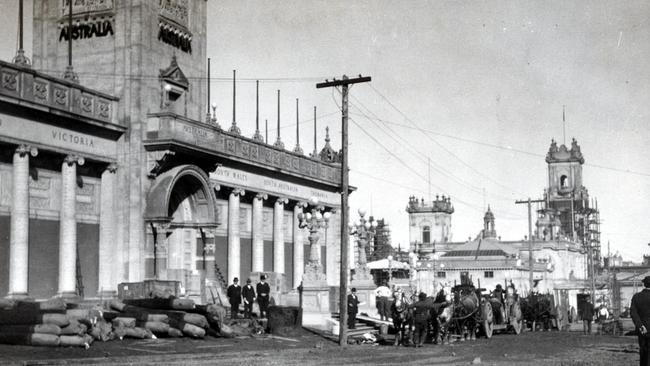Wartime fair helped Australia fall for all things American
A century ago the US opened an exposition heralding the opening of the Panama Canal and trumpeting their place as a Pacific power

Today in History
Don't miss out on the headlines from Today in History. Followed categories will be added to My News.
A century ago today America opened a world fair, ostensibly to celebrate the completion of the Panama Canal. But the Panama-Pacific International Exposition, held in San Francisco, was also trumpeted as a triumph over adversity, given that a large part of San Francisco had been destroyed by an earthquake and fire in 1906, yet still managed to put on a fabulous display of architecture, innovation and produce from around the world.
Among the many foreign exhibitors was Australia, which built a large pavilion with a classical facade despite the privations of the war. We were one of the many nations to come away from the exposition impressed by American innovation in many different fields. America was signalling its rising dominance in the Pacific and the fair helped spark an Australian love affair with things American.
The San Francisco exposition came as a welcome distraction from news of war in Europe. Although war reduced the number of participating nations, it had been too many years in the planning and too much of the exposition city had been built for it to be cancelled at the outbreak of war in 1914. The fact that the US was not yet at war left them clear to forge ahead.
An exposition to celebrate the canal’s approaching completion had been proposed as early as 1904. San Francisco and San Diego both bid to host the event: both would do so (San Diego’s was smaller and more locally focused) but it took a decade to eventuate.
The 1906 earthquake and devastating fire had killed more than 3000 people and destroyed a large area of the city. But it did not deter the city from wanting to hold a world fair. Civic leaders wanted to show that the city was not broken by the disaster.
Shortly after the US Great White Fleet visited Australia in 1908, Australia was part of discussions for a 1913 exposition. The US wanted the event to celebrate the canal and mark the 400th anniversary of Spanish explorer Vasco Nunez de Balboa’s “discovery” of the Pacific. Australians initially declined to be involved.
The US went ahead regardless, raising millions of dollars in funds and awarding the main event to San Francisco in 1910. President William Taft broke ground for the site in October 1911.
The head of the exposition commission, former Colorado governor Alva Adams, visited here in 1913 to entice Australia into being part of the planned 1915 event.
When war broke out Australia debated whether it was wasting money to attend the exposition in war time. The government decided it was important to be a presence at a Pacific-focused exposition, to stake our place as a regional leader.
Trade and political necessities outweighed war considerations. Australians were also big fans of international expositions and the excitement building since 1913 could not be dulled by the still-distant rumblings of war.
San Diego held its exposition in January 1915, but the bigger fair opened on February 20 in San Francisco. The opening ceremony had been toned down out of respect for the war raging in Europe, a parade of warships cancelled, but everything was still on a grand scale.
Spread out over 250ha, the exposition “city” was made of temporary materials and featured a Tower of Jewels as its centrepiece. This 130m neoclassical tower was encrusted with glass jewels that shimmered in the sun or under spotlights at night.
On display was a large working model of the Panama Canal, showing off American engineering, along with a Model-T assembly line, automatic milking machines, aircraft, the latest in telephone technology including a line set up so that people in New York could hear the Pacific Ocean. Brothers Rollie, Will and Frank Fageol invented the “trackless train” — a small tractor pulling carriages — to carry people around the fair.
There were the latest techniques for building Californian bungalows, which would have an impact on Australian homes.
The Australian pavilion, officially opened by former PM Alfred Deakin in March, showcased our flora and fauna, livestock, precious gems, gold, textiles, stonework, furniture manufacture and Aboriginal artefacts. Live kangaroos and other wildlife were also imported to impress the locals.
But the American exhibits had a greater impact on the Australians, who sent back news of what they had seen and learned about the latest in cars, phones, films and construction. It had a similar impact around the world.
The buildings at the site were mostly demolished at the end if 1915 — except for a Palace of Fine arts, which remained and was completely rebuilt in the 1960s as a more permanent structure.
Originally published as Wartime fair helped Australia fall for all things American



